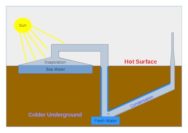
This has been an important goal in recent years, with the World Bank warning back in 2014 that these two vital commodities are on an unsustainable “collision course”.
Researchers in Saudi Arabia created a single device they say improves on previous attempts to combine energy and water production using solar power. Previous methods – which use, for example, salinity gradient and thermoelectrical conversions – reduced the efficiency of producing electricity, says Peng Wang from the King Abdullah University of Science and Technology.
To address this, he and colleagues developed a three-stage device that captures and recycles the heat generated by photovoltaic (PV) solar panels to produce clean water using multi-stage membrane distillation.
The PV panel generates a lot of heat, and the heat is considered a headache in PV,” Wang explains.
Recycling this heat several times within the membrane distillation system leads to a high water conversion rate while not compromising electricity generation, the researchers say in a paper published in the journal Nature Communications.
“The uniqueness of the device lies in its smart and effective use of the waste heat of the PV as a resource, which leads to its high efficiency in both electricity and fresh water production,” Wang says.
Tests show one square metre of solar panels can produce more than 1.64 kilograms of fresh water per hour from seawater, contaminated groundwater or industrial waste.
The researchers calculate that if the device were installed on the four billion square metres of land needed to generate global solar power capacity, expected to increase to 969 gigawatts by 2025, about four billion cubic metres of fresh water could be produced each year – equivalent to 10% of the total global drinking water consumption in 2017.
This could help make clean water more affordable and accessible for more than two billion people worldwide who struggle to access safe water.
Globally, 10% of water is used to produce energy from nuclear or fossil fuels, and this increases to between 50% and 90% in the US, Western Europe and China. In turn, a significant amount of energy – and costly infrastructure – is needed to produce clean drinking water via desalination.
The device, while not the first to make use of solar distillation, has a particular advantage: by combining two types of device that typically each require a large land area, and mounting systems, the approach is relatively compact.
Wang said the device turned the traditional link between water and electricity on its head: conventionally, electricity is produced by heating water to produce steam that is then used to turn turbines. While he said the team was still working on scaling up the device and reducing costs, they are optimistic.
“It is our hope that we move quickly to push this technology towards its large-scale adoption,” he said.
The researchers are now working on a second-generation device with a much higher water production rate, Wang says.
To scale it up and make it affordable, they will need to overcome engineering and technological barriers.
the illustration shows the basic principle of using heat to purify water.
2 Responses
This efficient water recovery technology looks promising. Between advancing efficiency with solar and wind energy production, we can likely look forward to less struggle for some of our basic needs. In fact, wind may be the best of our future sources of renewable energy; there is enough energy in the wind to supply all of civilization’s needs 100 times over. A gigantic river of kinetic energy flows just over our heads night and day, year-round.
I couldn’t agree more on this article